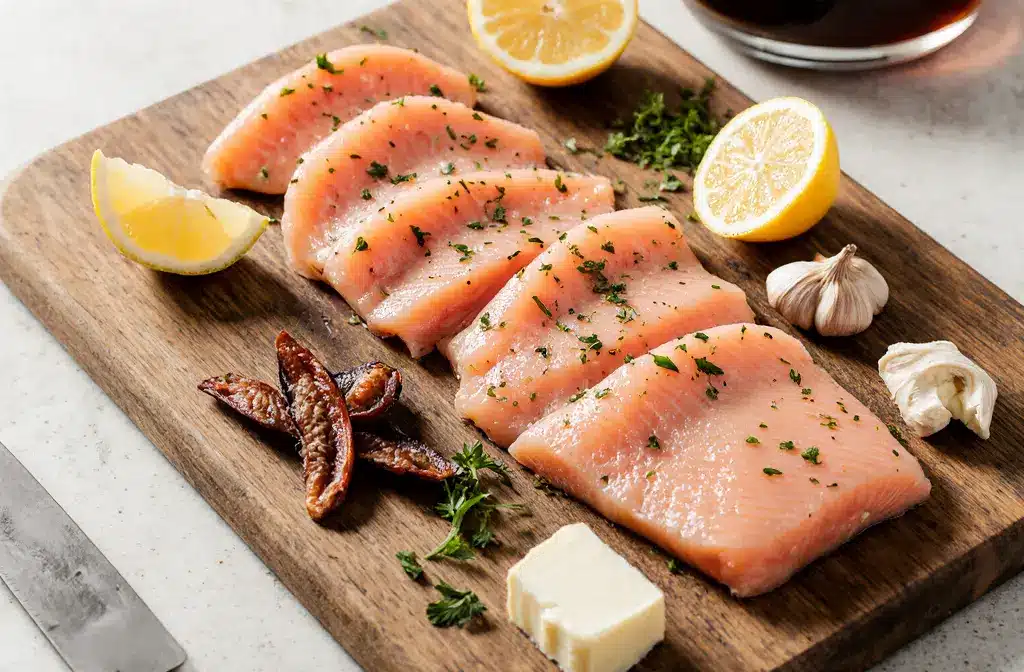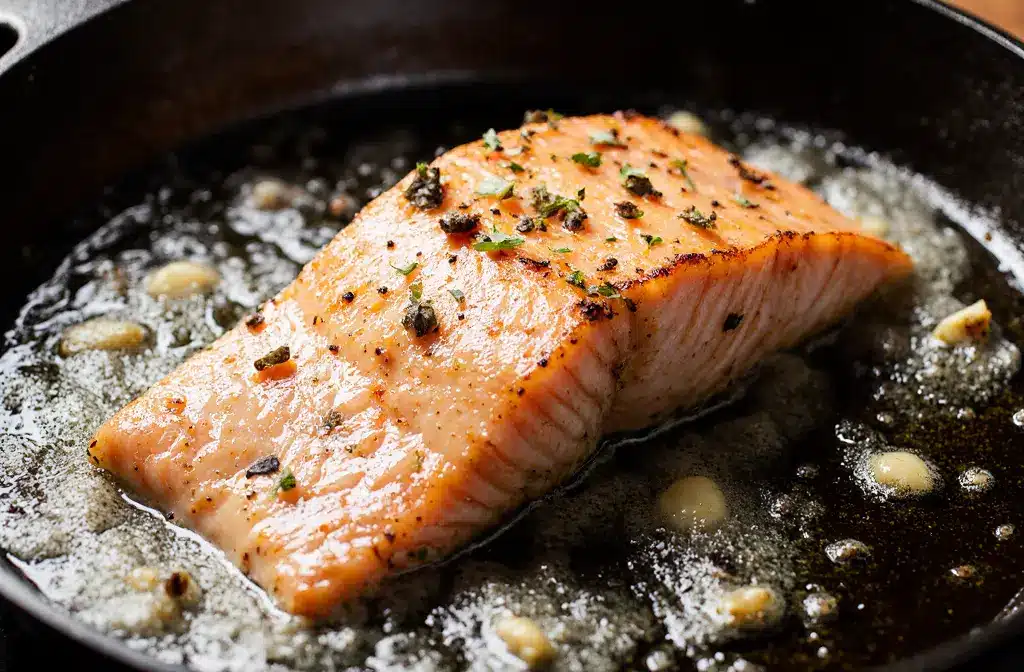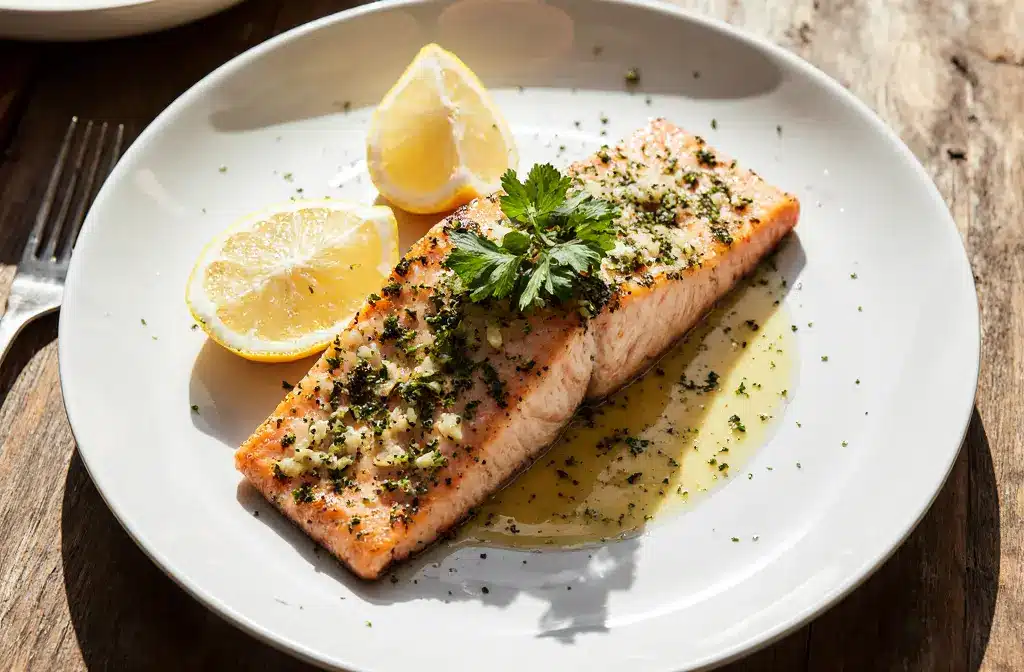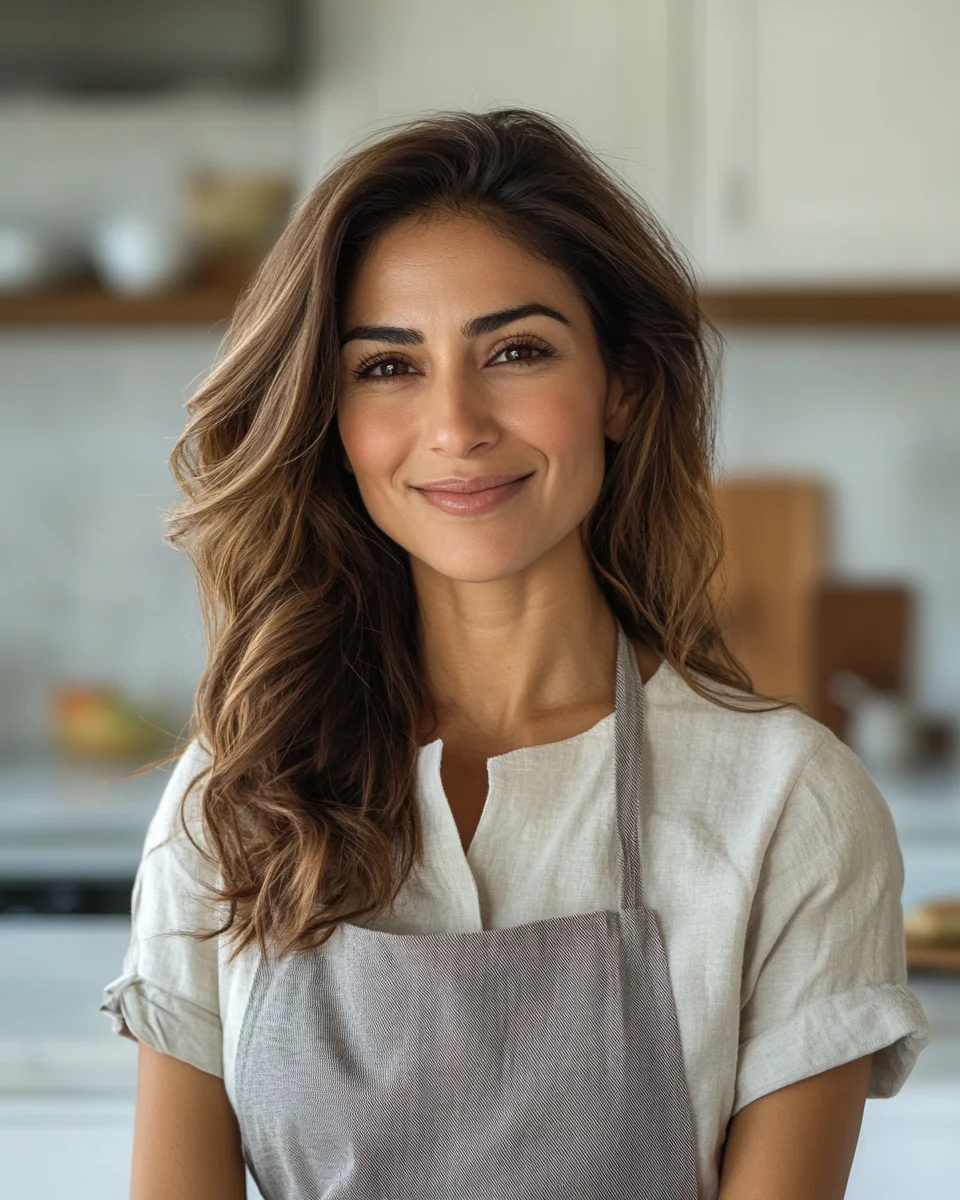I still remember the first time I tasted salmon with anchovy-garlic butter at a small bistro in San Francisco. One bite, and I was completely hooked. The rich, umami-packed butter didn’t just complement the salmon—it elevated it to an entirely different level. What seemed like an intimidating combination of flavors turned out to be pure culinary magic.
If you’re tired of the same old lemon-pepper salmon routine, this recipe is your ticket to restaurant-quality dinners at home. The secret lies in creating a compound butter that does double duty: it serves as both the cooking medium and the sauce, developing complex flavors as it browns and caramelizes in the pan.
Don’t let the word “anchovy” scare you away. These tiny fish dissolve completely into the butter, leaving behind only a deep, savory richness that enhances rather than overpowers the delicate salmon. Even anchovy skeptics in my family request this dish regularly—they often can’t even identify what makes it taste so incredible.
This technique transforms an ordinary weeknight dinner into something special enough for entertaining, yet simple enough to master on your first try. In just 20 minutes, you’ll have perfectly cooked salmon with crispy skin, nestled in a glossy, aromatic butter sauce that’s begging to be soaked up with crusty bread.
Whether you’re cooking for picky eaters, seafood lovers, or anyone in between, this anchovy-garlic butter salmon delivers on flavor, nutrition, and that all-important “wow factor” that makes dinner feel like an event rather than a chore.
The Science Behind Our Umami Butter Recipe
Understanding why this combination works so brilliantly will make you a better cook and help you recreate these flavors in other dishes. Anchovies are nature’s umami bombs—they’re packed with glutamates that enhance the perception of savory flavors in everything they touch. When mashed into butter with garlic, they create what food scientists call a “flavor carrier system.” Learn more about the science of umami and how it enhances flavor here.
The compound butter technique serves multiple purposes in this recipe. First, it ensures even distribution of flavors throughout the cooking process. As the butter melts in the hot pan, it creates the perfect medium for browning the salmon while simultaneously building the pan sauce. The milk solids in the butter brown and develop nutty notes, while the anchovies and garlic caramelize, creating layers of complexity you simply can’t achieve with oil alone.
Temperature control is crucial for success. The initial high heat creates the Maillard reaction—that beautiful browning on the salmon skin that locks in moisture and creates texture contrast. Then, reducing the heat allows the garlic to cook without burning while the remaining compound butter slowly melts into a luxurious sauce.
Essential Ingredients for Perfect Salmon
Each ingredient in this recipe serves a specific purpose. The anchovies provide umami depth and salinity, eliminating the need for additional salt in most cases. Fresh garlic offers pungency and sweetness when cooked, while high-quality butter creates richness and helps carry flavors. The salmon itself should be center-cut fillets with skin on—the skin crisps beautifully and protects the delicate flesh from overcooking.
Equipment You’ll Need (Plus Smart Alternatives)
The ideal setup includes a large, heavy-bottomed skillet (cast iron or stainless steel work best) and a flexible fish spatula. However, you can achieve excellent results with a non-stick pan if that’s what you have—just be gentle with the fish. An instant-read thermometer takes the guesswork out of doneness, but visual and tactile cues work well once you’ve made this recipe a few times.
Complete Ingredient List with Pro Substitutions
For the Salmon:
- 4 salmon fillets (6 oz each), skin-on, center-cut preferred
- 1/2 teaspoon freshly ground black pepper
- 1/4 teaspoon kosher salt (optional, anchovies provide saltiness)
For the Anchovy-Garlic Compound Butter:
- 6 tablespoons unsalted butter, softened to room temperature
- 4-6 anchovy fillets, oil-packed, minced to paste
- 4 large garlic cloves, minced
- 1/4 teaspoon fresh cracked black pepper
- 1 tablespoon fresh lemon juice
- 2 tablespoons fresh parsley, finely chopped (for serving)
- Lemon wedges for serving
Smart Substitutions:
- Anchovy-free option: Replace with 1 tablespoon fish sauce or Worcestershire sauce
- Garlic alternatives: Use 1 teaspoon garlic powder if fresh isn’t available
- Butter substitutes: For dairy-free, use high-quality vegan butter or ghee
- Salmon alternatives: This butter works beautifully with halibut, sea bass, or even chicken thighs
Ricotta Cheese Recipe — for homemade cheese ideas that complement fish dishes.

Step-by-Step: Cooking Anchovy-Garlic Butter Salmon
Preparing the Anchovy-Garlic Compound Butter
Start by bringing your butter to room temperature—this is crucial for proper mixing. In a small bowl, combine the softened butter, minced anchovies, minced garlic, and black pepper. Using a fork, mash everything together until completely incorporated. The mixture should be smooth and uniform in color. This compound butter can be made up to 3 days ahead and refrigerated, or even frozen for up to a month.
Pro tip: If your butter isn’t soft enough, microwave it for 5-10 seconds at a time until it yields to gentle pressure but isn’t melted.
Pan-Searing Technique for Perfect Results
Remove salmon from refrigeration 15 minutes before cooking to bring it closer to room temperature—this ensures even cooking. Pat the fillets completely dry with paper towels and season the flesh side with pepper and a light sprinkle of salt if desired.
Heat a large, heavy-bottomed skillet over medium-high heat. Add about half of your compound butter to the pan. As soon as it melts and begins to foam, carefully place the salmon fillets skin-side down in the pan. The sizzle should be immediate and vigorous—if not, increase the heat.
Cook undisturbed for 3-4 minutes, allowing the skin to become golden and crispy. Resist the urge to move or peek at the fish. Use a thin spatula to gently check if the skin releases easily from the pan—if there’s resistance, give it another minute.
Carefully flip the salmon using a fish spatula or thin regular spatula. The skin should be beautifully golden and crispy. Cook for an additional 2-3 minutes for medium doneness (internal temperature of 125-130°F) or 4-5 minutes for well-done (140°F).
Finishing Touches and Plating
Remove the salmon to a warm platter and immediately add the remaining compound butter to the still-hot pan. Let it melt and bubble for 30 seconds, swirling to combine with any fond (browned bits) left from cooking the fish. Add the lemon juice and swirl again—the sauce should be glossy and aromatic.
Spoon the anchovy-garlic butter sauce over the salmon fillets, ensuring each piece gets an equal amount. Sprinkle with fresh parsley and serve immediately with lemon wedges on the side.

Professional Chef Tips for Restaurant-Quality Results
How to Choose the Perfect Salmon Fillet
Look for bright, firm flesh with no brown spots or strong fishy smell. Wild-caught salmon offers superior flavor and texture, but high-quality farmed salmon works well too. Center-cut fillets cook most evenly, and skin-on pieces stay moister during cooking. If your fillets have pin bones, remove them with tweezers before cooking.
Temperature Control Secrets
The key to perfect salmon lies in understanding heat management. Start with medium-high heat to create the initial sear, then reduce to medium once you flip the fish. This prevents the garlic from burning while ensuring the salmon cooks through evenly. An instant-read thermometer is your best friend—salmon is perfectly cooked at 125°F for medium-rare or 135°F for medium.
Common Mistakes to Avoid
Never cook salmon straight from the refrigerator—cold fish cooks unevenly. Don’t move the fish once it hits the pan; patience creates that perfect crispy skin. Avoid overcrowding the pan, which leads to steaming rather than searing. Finally, don’t skip the resting step—let the compound butter come to room temperature for easy mixing and optimal flavor distribution.
Recipe Variations for Every Diet
Keto and Low-Carb Version
This recipe is naturally keto-friendly, providing healthy fats and high-quality protein with virtually zero carbohydrates. To boost fat content further, add an extra tablespoon of butter or serve over cauliflower rice drizzled with the pan sauce. The anchovy-garlic butter also pairs beautifully with roasted vegetables like asparagus or Brussels sprouts.
Dairy-Free Anchovy Butter Alternative
Replace butter with an equal amount of high-quality olive oil mixed with minced anchovies and garlic. While you won’t get the same rich mouthfeel, the flavors remain intense and delicious. Alternatively, use ghee, which provides richness without lactose. Coconut oil works in a pinch but will add subtle tropical notes to the dish.
Mild Version for Anchovy Skeptics
If you’re introducing someone to anchovies, start with just 2 fillets instead of 4-6, and add 1 tablespoon of capers for extra brininess without the anchovy intensity. You can also substitute 1 teaspoon of fish sauce, which provides umami depth with a more familiar flavor profile.
Seasonal Flavor Variations
Spring version: Add fresh dill and lemon zest to the compound butter, serve with asparagus and new potatoes.
Summer version: Include minced fresh basil and cherry tomatoes in the pan during the last minute of cooking.
Fall version: Add a pinch of smoked paprika and serve with roasted root vegetables.
Winter version: Include fresh thyme and rosemary in the compound butter for warming, herbaceous notes.
Neiman Marcus Chicken Casserole — for another elegant chicken-based dinner option.
Frequently Asked Questions About Anchovy-Garlic Butter Salmon
Q: Can I make the compound butter ahead of time?
A: Absolutely! The compound butter actually improves in flavor when made 24 hours ahead. Store covered in the refrigerator for up to 3 days or freeze for up to 1 month.
Q: What if I can’t find anchovy fillets?
A: Anchovy paste works well—use 1 tablespoon instead of 4-6 fillets. Fish sauce (1 tablespoon) or Worcestershire sauce (2 teaspoons) provide similar umami depth.
Q: How do I know when the salmon is perfectly cooked?
A: The internal temperature should reach 125°F for medium-rare or 135°F for medium. The flesh should be opaque and flake easily when tested with a fork.
Q: Can I use frozen salmon?
A: Yes, but thaw it completely first and pat very dry. Previously frozen salmon may release more moisture during cooking, so be patient with the searing process.
Q: Why is my garlic burning?
A: Reduce the heat to medium after flipping the salmon. Garlic burns quickly at high temperatures, creating bitter flavors.
Q: Can I remove the skin before cooking?
A: You can, but the skin helps protect the fish from overcooking and adds textural contrast. If removing, reduce cooking time slightly.
Q: What’s the best way to reheat leftovers?
A: Gently reheat in a low oven (300°F) for 8-10 minutes, or carefully warm in a skillet over low heat with a splash of butter.
Q: Can I double this recipe?
A: Yes, but cook the salmon in batches to avoid overcrowding. Keep the first batch warm in a 200°F oven while cooking the second.
Q: How long does leftover compound butter last?
A: Refrigerate for up to 1 week or freeze for up to 3 months. It’s excellent on steaks, vegetables, or spread on bread.
Q: What wine pairs well with this dish?
A: Crisp white wines like Sauvignon Blanc or Pinot Grigio complement the richness, while light reds like Pinot Noir work beautifully too.
Q: Can I use this butter on other proteins?
A: Definitely! It’s outstanding with chicken thighs, pork chops, or even grilled vegetables.
Q: How do I prevent the salmon from sticking?
A: Ensure your pan is properly preheated and the fish is completely dry. Don’t move the salmon until it releases naturally from the pan.
Nutritional Benefits of Salmon and Anchovies
Omega-3 Content and Heart Health
This salmon dish is a nutritional powerhouse, providing approximately 1,500-2,000mg of omega-3 fatty acids per serving—well above the recommended daily intake. These essential fats support heart health, brain function, and may help reduce inflammation throughout the body. The combination of salmon and anchovies doubles down on these benefits, as both fish are excellent sources of EPA and DHA omega-3s.
Complete Nutritional Breakdown
Per serving (approximate):
- Calories: 385
- Protein: 35g
- Fat: 26g (primarily healthy unsaturated fats)
- Carbohydrates: 2g
- Sodium: 450mg
- Potassium: 628mg
- Vitamin D: 45% Daily Value
- Vitamin B12: 125% Daily Value
- Selenium: 85% Daily Value
The anchovies contribute additional calcium and vitamin D, while garlic provides antioxidants and potential cardiovascular benefits. This dish fits perfectly into Mediterranean, keto, and paleo dietary patterns.
Omega-3 Dosage Guide for Inflammation — to educate readers on omega-3 importance.
Storage, Meal Prep, and Leftover Magic
Proper Storage Techniques
Cooked salmon with anchovy-garlic butter keeps in the refrigerator for up to 3 days when stored in an airtight container. The compound butter can be made up to a week ahead and stored separately. For best results, store the fish and any extra sauce in separate containers to prevent the fish from becoming soggy.
Make-Ahead Strategies
Prepare the compound butter up to 3 days in advance—the flavors actually improve with time. You can also portion and season the salmon fillets the morning of cooking, keeping them covered in the refrigerator. For busy weeknight dinners, prep all ingredients in the morning so you’re ready for a 15-minute cooking session.
Creative Leftover Ideas
Flake leftover salmon into scrambled eggs with fresh herbs for an elegant breakfast. Toss with pasta, adding pasta water to create a silky sauce. Mix into salads for added protein, or use as a topping for avocado toast. The compound butter is excellent melted over roasted vegetables or stirred into risotto.
Perfect Pairings and Serving Suggestions
This rich, savory salmon pairs beautifully with bright, acidic sides that cut through the butter’s richness. Consider a simple arugula salad with lemon vinaigrette, roasted asparagus with lemon zest, or garlic-herb roasted potatoes. For starch options, try orzo with fresh herbs, wild rice pilaf, or crusty sourdough bread to soak up the incredible pan sauce.
Wine pairings should complement both the salmon’s richness and the anchovy-garlic flavors. Crisp whites like Albariño or Vermentino work beautifully, as do light, earthy reds like Côtes du Rhône or Sangiovese.

More Gourmet Salmon Recipes You’ll Love
If this anchovy-garlic butter technique won your heart, try these related recipes: Lemon-Herb Compound Butter Salmon, Mediterranean Salmon with Olive Tapenade, or Brown Butter Salmon with Capers. For similar umami-rich preparations, explore Miso-Glazed Salmon or Salmon with Sun-Dried Tomato Pesto.
Each of these recipes builds on the fundamental techniques you’ve mastered here while introducing new flavor combinations that will keep your dinner rotation exciting and delicious. For more creative recipe ideas and cooking techniques, visit the Food Network’s salmon recipes collection for inspiration.






4 thoughts on “Why This Anchovy-Garlic Butter Salmon Will Transform Your Weeknight Dinners”